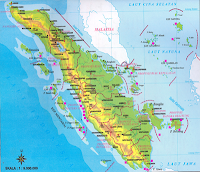"Today I'll give you an interesting topic about Indonesia, Indonesia has thousand islands, and has the most islands in the world. 5 of them are including the largest island in the world, Ok let's start from west to east!"
1. Sumatera

This Island is known as Percha Island,Andalas,and
Suwarnadwipa. Sumatera is 6th largest island in the world,has 8 provinces,and the largest city is Medan(pop. 2,109,330 (as of 2010)).Sumatera has beautiful scenery,abundant resources,amazing animals.and high culture.Moreover most sumatran are settled foreigner in Java,especially Batak and Minang.
Area : 473,481 km2(182,812 sq mi)
Area rank : 6th
Population : 50,365,538 (as of 2010)
Ethnic Groups : Acehnese, Batak,Minangkabau, Malay
Largest City : Medan
2. Java

The second island is Java. We already know that Java is the smallest island of top 5 big island in Indonesia,and I think java has most terrible title,as you know most people in Indonesia live here,especially on west.Many Indonesian come here to change their life,especially at Jakarta. This island is very crowded, about 100 million live here,that means half of indonesian citizen. Beside that Java has high culture,and has been popular to all over the world,such as Jaipong dance,Ondel-ondel,Gamelan,Angklung,Reog ponorogo and so on.
Area : 128,297 km2 (49,535.7 sq mi)
Area rank : 13th
Population : 138 million (as of 2011)
Largest City : Jakarta
3.Kalimantan
Indonesian know it as Kalimantan but western call it Borneo.This island is owned by 3 countries,Indonesia,Malaysia,and Brunei Darusalam. Kalimantan well known about its forest and deforestation. This Island has wide jungle and cases of forest destruction. High quality of wood grow here,so that illegal loggers live here depend. This island inhabited by dayak tribes,they're the native.This island has many beautiful animals and plants but many of them are member of endenger species too.Most of citizen's job are farmer and fisher.Most of them depend their life at mahakam river, there's so many floating market.
Area : 743,330 km2 (287,001 sq mi)
Area rank : 3rd
Population : 18,590,000 (as of 2009)
Largest City : Kuching (Serawak,Malaysia)
4.Celebes
I think Celebes is most endemic island in Indonesia,why? It has different charasteristic from any tropical world ,ranging from its plant and animals. Sulawesi is part of Wallacea, meaning that it has a mix of both Asian and Australasian species. So ,Celebes has originality.Not only terrestrial life but also the marine life has beautiful scenery.We know that bunaken is very popular marine park and Lembeh Island has amazing diversity of fish .Sulawesi is important island ,it has 6 provinces and the biggest city is Makassar.
Area : 174,600 km2 (67,410 sq mi)
Area rank : 11th
Population : 16 million (as of 2005)
Largest City : Makassar
5. New Guinea
New Guinea is the 2nd largest island in the world it owned by two countries,Indonesia and Papua NewGuinea.
This island has similarity with australia,you can search the flora and fauna and compare with australian.Rich of natural resources
and culture ,this island is become place of research and mining.The people still outdated ,tribe war still occur,few decent roads,and there's so many region that has no electicity.
Area : 786,000 km2 (303,500 sq mi)
Area rank : 2nd
Population : ~ 7.5 million (as of 2005)
Largest City :-




 Its culture is no less interesting, gamelan has been popular in the world,wayang kulit become artistic and interesting puppet show, Ondel-ondel is the funniest carnival in Jakarta and Angklung is the most compact music art. Ok that's all for today I hope we can keep Java still beautiful. :)
Its culture is no less interesting, gamelan has been popular in the world,wayang kulit become artistic and interesting puppet show, Ondel-ondel is the funniest carnival in Jakarta and Angklung is the most compact music art. Ok that's all for today I hope we can keep Java still beautiful. :)




























